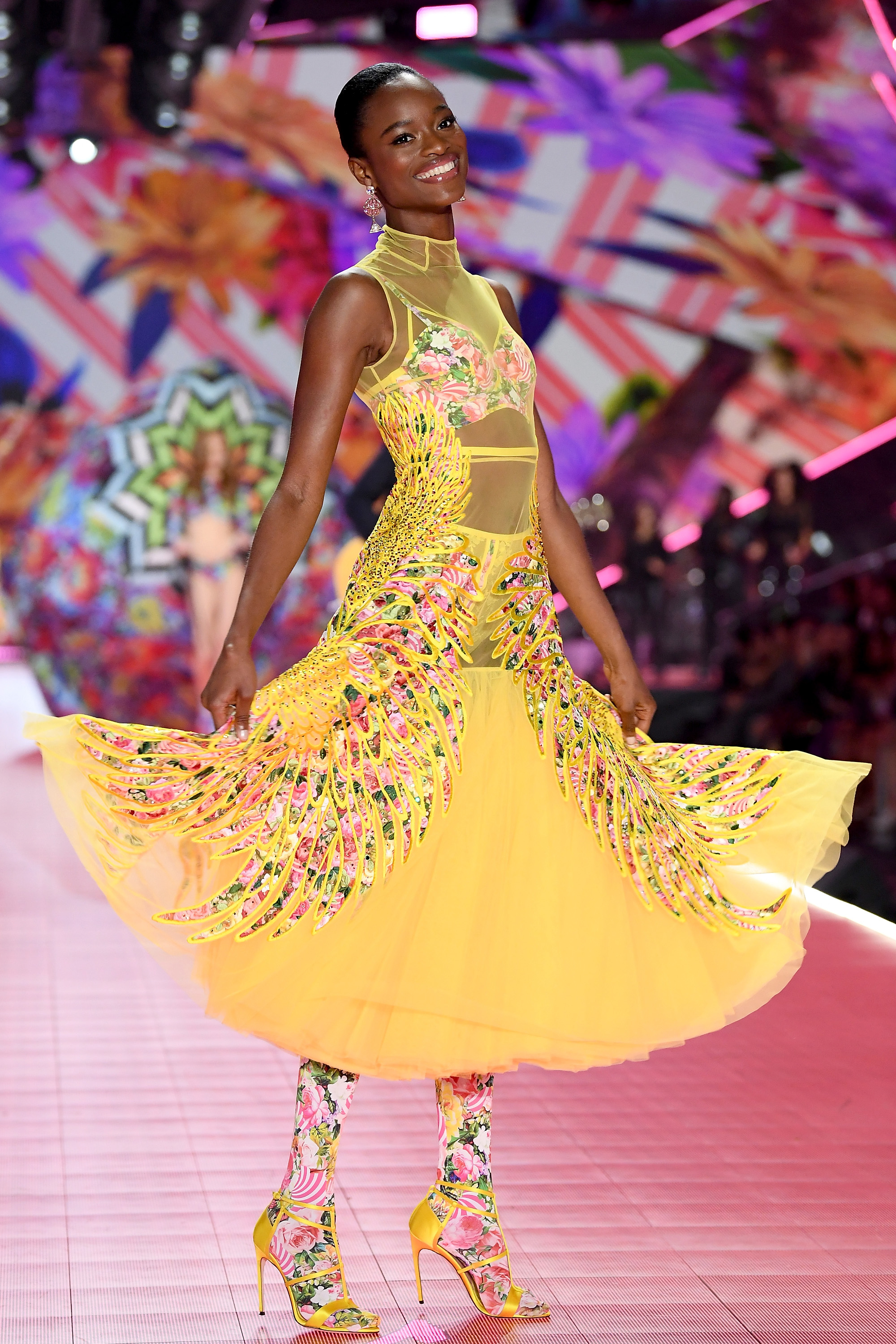
Above: The Difference Between Haute Couture And Prêt-À-Porter (Ready-To-Wear) In Fashion Modeling. How To Become A Haute Couture Fashion Model.
Are you a brand new fashion model and wondering what is the difference between Prêt-à-Porter (ready-to-wear) and Haute Couture? Well, wonder no more as we explain from a high fashion point of view the real difference between Haute Couture and Prêt-à-Porter (ready-to-wear) not just for women in general, but also for New York fashion models getting ready for their first Haute Couture and Prêt-à-Porter (ready-to-wear) runway shows in Paris, France.
Probably the two most misused and abused words in the world of high fashion modeling are Prêt-à-Porter (ready-to-wear) and Haute Couture. While these fashion words are casually thrown around and used by even the most experienced high fashion designers, there are indeed very specific meanings to those two extremely important fashion words.
Before we start, it is very important to know the literal meanings behind these beautiful sounding French phrases. Prêt-à-Porter literally means Ready-to-Wear. Haute Couture is generally used to describe anything High Fashion. This is not too far off from its true French meaning, as Haute Couture literally means high sewing or high dressmaking in English.
What Is Haute Couture In Fashion Modeling & What Are The Top Haute Couture Modeling Agencies For Haute Couture Fashion Models?
Every Haute Couture piece is made to measure for a single woman. Every woman interested in purchasing Haute Couture will go to a Parisian atelier for measurements and fittings. This is because every Haute Couture piece is tailored to each individual woman, both in style and size.
Haute Couture fashion is considered the highest quality in the world of high fashion, and will generally also be sold at the highest possible prices (if you need to ask for the price of your Haute Couture gown at your favorite Parisian atelier, you probably should not be purchasing Haute Couture gowns in the first place). In addition, there are actually specific high fashion standards that a Haute Couture piece much reach to be deemed Couture. Vogue magazine (known as the fashion Bible) once described Couture pieces as walking pieces of art, which is indeed true because Haute Couture pieces are designed to be worn by very few women, and many times, just one woman.
Regardless of how exclusive a Haute Couture piece is, it is not really Haute Couture until the Chambre Syndicale de la Haute Couture in France actually says it is Haute Couture. Upon the Chambre Syndicale de la Haute Couture’s seal of approval, a fashion house is considered Haute Couture by French law. This is not very easy to achieve, as there are strict fashion criteria a fashion house must meet to even be considered Haute Couture. First, a fashion house must have a workshop in Paris France that employs at least fifteen full-time staff members. Second, the fashion house must design made-to-order pieces for women with at least one fitting. These high fashion standards ensure that Haute Couture labels deliver impeccably tailored dresses and gowns that will be an exact and perfect fit for each and every woman. Understandably, there are only approximately fifteen Haute Couture studios in Paris France today, including widely acclaimed and world renowned Haute Couture fashion houses Chanel and Dior.
Haute Couture gowns and Haute Couture dresses are gowns and dresses made of the highest quality in the world of high fashion. All Haute Couture gowns and Haute Couture dresses are handmade, are made to measure using the exact body measurements of a woman (bust, waist, hips, etc.), and require much time and skill to produce. Thus, this level of extreme high quality in the Haute Couture production process means that Haute Couture gowns and Haute Couture dresses are sold at very high prices to generally very wealthy women. In other words, customers of Haute Couture gowns and Haute Couture dresses are generally in the top percentile of wealth, as Haute Couture is the highest you can pay with money within the fashion industry.
Haute Couture houses create a collection every summer and winter season. These Haute Couture collections often set the stage for future fashion trends within the Prêt-à-Porter collections (this is because Prêt-à-Porter collections often take inspiration from high fashion).
Haute Couture fashion houses are committed to present fashion collections twice each year, and these fashion collections must have at least 35 pieces (both day and evening wear). These Haute Couture fashion collections are presented at Haute Couture fashion shows every 6 months (half a year in advance) using experienced Haute Couture runway models from the top Haute Couture modeling agencies in the world (many of the top modeling agencies in the world have a modeling agency branch or office in Paris, France).
For example, the summer Haute Couture fashion collection of a Haute Couture fashion house will generally be presented in Paris in January (approximately 6 months in advance), while the Haute Couture winter collection will be presented around July of each year. Haute Couture runway shows are beautiful, artistic, elaborate, and visually exciting fashion shows featuring many famous Haute Couture runway models that are represented by many of the most prestigious modeling agencies for runway models from Paris, New York, and from around the world. With elaborate sets and invite-only guest lists, these Haute Couture fashion shows are as exclusive as the Haute Couture pieces themselves.
What Is Prêt-À-Porter In Fashion Modeling & What Are The Top Prêt-À-Porter Modeling Agencies For Prêt-À-Porter Fashion Models?
Prêt-à-Porter is high quality, factory made fashion. While Prêt-à-Porter clothing is not necessarily mass produced, it is available to a wide variety of women around the world. Prêt-à-Porter fashion collections are made for many women in different sizes, and while they range in price and quality, a common characteristic of Prêt-à-Porter is that their fashion collections are designed within the bounds of standardized sizing for women. In addition, Prêt-à-Porter dresses and gowns are not meant to fit perfectly or require a tailor (Prêt-à-Porter clothing simply fits the majority of women fairly well without the need of a tailor).
Usually Prêt-à-Porter clothing is available twice each year, and these fashion collections are not made to order. The rate at which fashion companies are able to produce Ready-to-Wear fashion collections varies from Haute Couture in that Ready-to-Wear fashion collections for women are produced at faster rates, and in higher quantities. While Prêt-à-Porter dresses may be of high quality and take inspiration from Haute Couture dresses and Haute Couture gowns, the Prêt-à-Porter fashion collections lack the exclusivity of Haute Couture clothing since women could find Prêt-à-Porter clothing (dresses, skirts, etc.) in many different high fashion retail stores (including their online stores).
Prêt-à-Porter fashion shows are generally presented one year in advance. Haute Couture fashion brands, such as Chanel and Dior, often present a Prêt-à-Porter fashion collection. These Prêt-à-Porter fashion collections are generally presented during Fashion Week (which is not really a week but more like an entire month), a period of time when every name in fashion gathers in specific cities located around the world (which is why Fashion Week is extremely exhausting and stressful for even the most experienced runway models). The most famous of these fashion weeks take place in New York, London, Milan, and Paris (also known as the four fashion capitals of the world). Prêt-à-Porter fashion shows are also often elaborate and artistic, with exclusive guest lists for celebrities, the press, industry insiders (such as retail fashion buyers and fashion magazine editors), and of course very wealthy women with a lot of money and free time on their hands to actually purchase those beautiful fashion dresses and skirts as seen on the fashion runways of the world.









